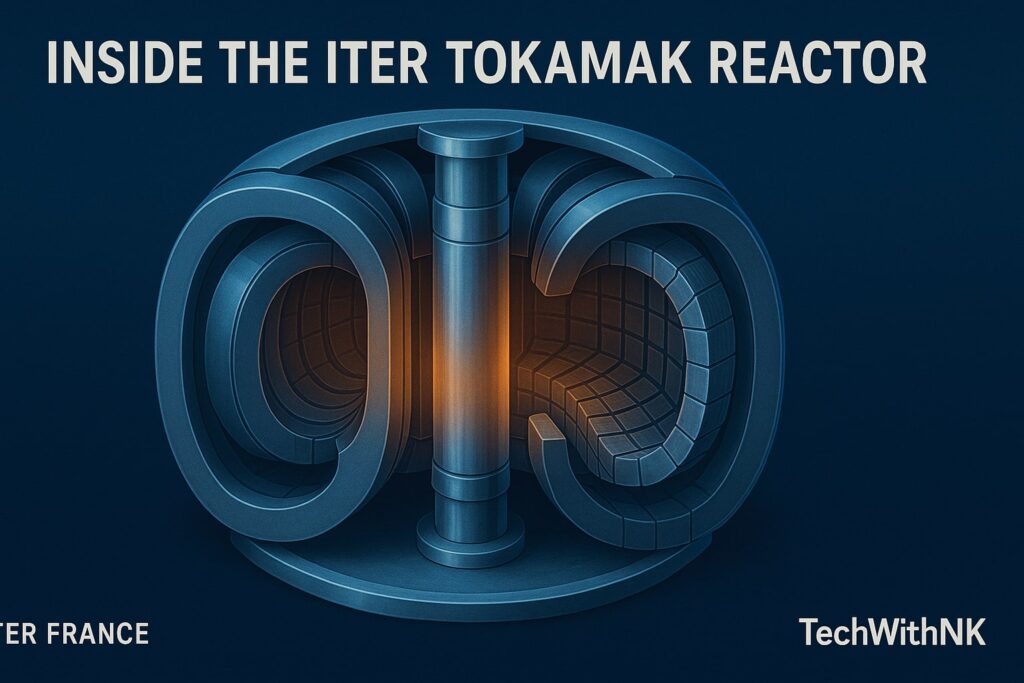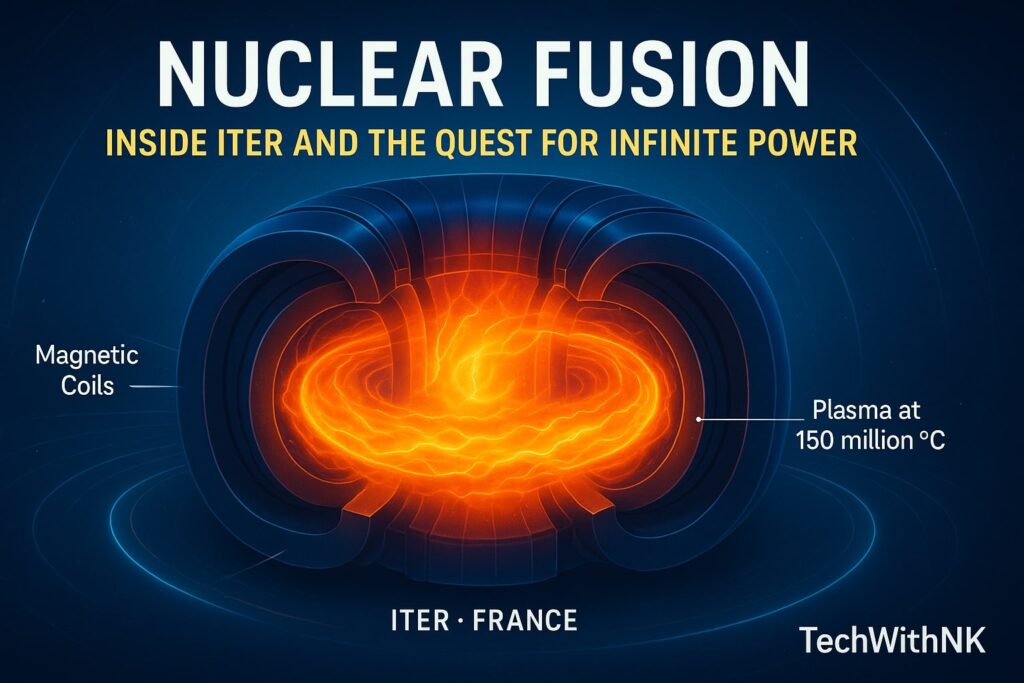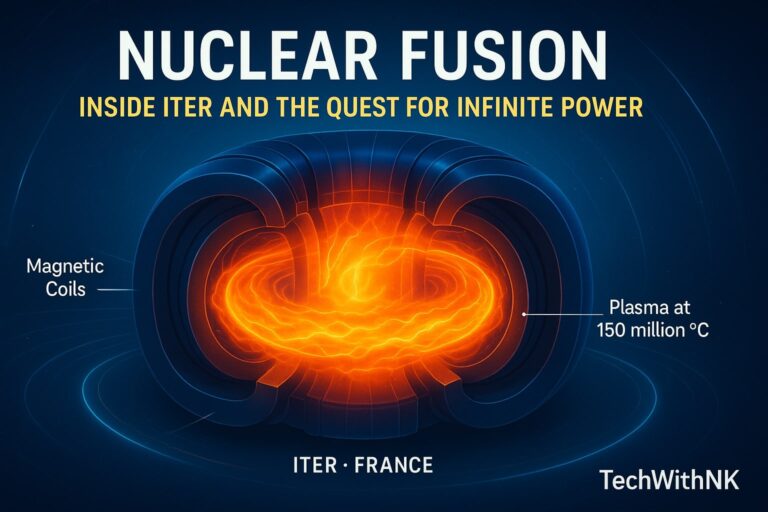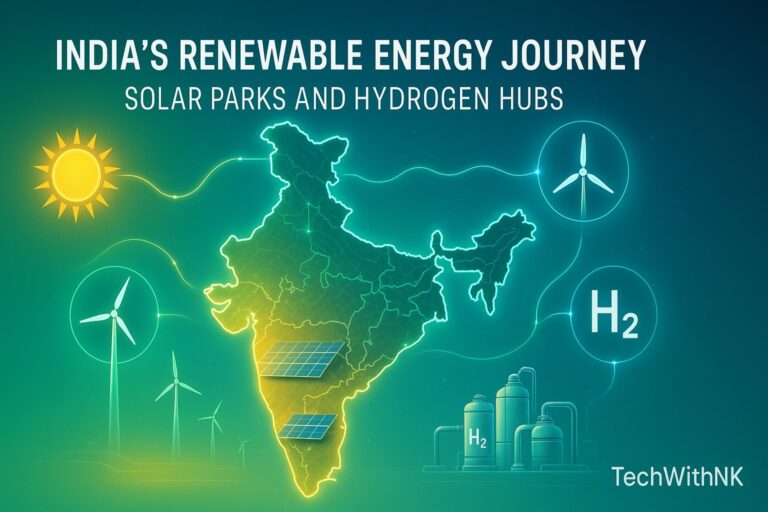🌞 Introduction: The Dream of Infinite, Clean Energy
For over a century, humanity has harnessed energy by burning fuels — coal, oil, gas, or even uranium for fission. But nature has always offered a more elegant solution: nuclear fusion, the process that powers the Sun and all stars.
Imagine a world where a cup of seawater could light up an entire city, where no carbon emissions are released, and where energy never runs out. This is not science fiction — it’s the promise of fusion energy, and the ITER project in France stands at the heart of that dream.
Let’s dive deep into how ITER (International Thermonuclear Experimental Reactor) is building the most complex machine in human history to unlock the power of the stars on Earth.
⚛️ What Is Nuclear Fusion?
At its core, nuclear fusion is the process where two light atomic nuclei combine to form a heavier nucleus, releasing a massive amount of energy.
This is the opposite of nuclear fission, used in today’s power plants, where atoms like uranium are split apart.
Fusion Reaction Example (Deuterium + Tritium):
^2H + ^3H → ^4He + n + 17.6 MeV
That means deuterium (D) and tritium (T) — both forms of hydrogen — combine to form helium, a neutron, and 17.6 million electron volts (MeV) of energy per reaction.
To put it simply — fusion is about 4 times more efficient than fission and nearly 10 million times more energy dense than chemical fuels.
🌊 The Fuel: Hydrogen from Seawater and Lithium
One of fusion’s greatest advantages is fuel abundance.
Deuterium can be extracted from seawater (1 liter of seawater contains enough deuterium to power your home for a year).
Tritium can be bred from lithium, a metal found in rocks and even batteries.
Unlike fossil fuels or uranium, fusion fuels are nearly limitless and produce no long-lived radioactive waste.
🔥 Why Is Nuclear Fusion So Hard to Achieve?
To make fusion happen, the atomic nuclei must overcome their natural repulsion (Coulomb barrier). This only occurs at extremely high temperatures — around 150 million °C, 10 times hotter than the Sun’s core!
At this temperature, matter becomes plasma — a hot, charged gas of ions and electrons.
The challenge?
Contain this ultra-hot plasma without touching any material walls, or it will instantly cool down and the reaction will stop.
That’s where magnetic confinement comes in.

🌀 The Tokamak: Magnetic Bottle for Plasma
The most successful design to confine fusion plasma is called a Tokamak, invented in the Soviet Union in the 1950s.
A Tokamak uses strong magnetic fields to trap plasma in a donut-shaped chamber (called a torus), preventing it from touching the walls.
Key Components of a Tokamak:
Toroidal Field Coils – create the circular magnetic field around the plasma.
Central Solenoid – induces plasma current to heat and stabilize it.
Vacuum Vessel – maintains ultra-high vacuum for plasma purity.
Cryostat – keeps superconducting magnets at -269°C (colder than space).
Blanket Modules – absorb escaping neutrons and produce tritium.
This is the design chosen for ITER, the world’s largest fusion experiment.
🌍 Inside ITER – The World’s Largest Science Project
ITER (International Thermonuclear Experimental Reactor) is being built in Saint-Paul-lès-Durance, France, as a global collaboration of 35 nations including India, the EU, USA, Japan, China, Russia, and South Korea.
Key Facts about ITER:
| Parameter | Value |
|---|---|
| Plasma Temperature | 150 million °C |
| Plasma Volume | 840 m³ |
| Fusion Power Target | 500 MW (from 50 MW input) |
| Energy Gain (Q) | Q = 10 |
| Construction Cost | ~$25 billion |
| Operational Target | 2035 (Full Plasma Operation) |
ITER aims to demonstrate net energy gain — producing 10 times more energy than it consumes, a world first.
🧩 The Engineering Marvel
ITER is not just a physics experiment — it’s an engineering masterpiece.
1. Superconducting Magnets
18 toroidal field coils generate 11.8 Tesla magnetic fields (250,000× stronger than Earth’s magnetic field).
Built using niobium-tin superconductors cooled by liquid helium.
2. Cryostat
A massive 30-meter-tall stainless steel chamber (heaviest component: 3,850 tonnes).
Keeps magnets at cryogenic temperatures.
3. Vacuum Vessel
Double-walled chamber with neutron shielding and tritium breeding layers.
India is responsible for manufacturing key sections of this vessel.
4. Plasma Heating Systems
Ohmic Heating (via plasma current).
Neutral Beam Injection (injecting fast hydrogen atoms).
Radiofrequency Heating (using electromagnetic waves).
Together, they heat plasma to 150 million °C.
🇮🇳 India’s Role in ITER
India, represented by ITER-India (part of the Institute for Plasma Research, Gandhinagar), contributes about 9% of the total project value in components and engineering.
India’s Major Contributions:
Cooling systems and cryolines.
In-vessel shielding blocks.
Diagnostics and instrumentation systems.
India’s participation places it among the elite countries leading the future of fusion energy.
⚙️ How ITER Works – Step by Step
Plasma Generation
– Hydrogen isotopes (deuterium and tritium) are injected into the vacuum vessel.Magnetic Confinement
– Superconducting magnets form a stable magnetic cage to contain plasma.Plasma Heating
– RF waves and neutral beams heat the plasma to 150 million °C.Fusion Reactions Begin
– D + T → He + neutron + energy.Energy Extraction
– Neutrons hit the lithium blanket → produce heat + breed new tritium.Heat to Electricity (Future DEMO)
– In next-generation plants, this heat will drive turbines to generate electricity.
💡 Beyond ITER – DEMO and the Path to Fusion Power Plants
ITER is not a power plant. It’s an experimental step to prove the concept.
The next stage will be DEMO (Demonstration Power Plant) — planned for the 2050s. DEMO will:
Generate 2–4 GW of fusion power.
Convert heat into electricity for the grid.
Operate in a steady-state, not just short pulses.
After DEMO, commercial fusion reactors (like ARC, SPARC, and Indian DEMO projects) could supply endless, clean energy.
🌱 Why Fusion Energy Matters
Fusion addresses three global energy challenges simultaneously:
| Challenge | How Fusion Solves It |
|---|---|
| Climate Change | Zero CO₂ emissions |
| Energy Security | Fuel from seawater and lithium |
| Sustainability | Virtually infinite fuel supply |
Other benefits:
No meltdown risk (unlike fission).
Minimal radioactive waste.
No proliferation concerns.
Fusion could power civilization for millions of years.
🚀 Fusion Breakthroughs Around the World
While ITER leads large-scale research, other fusion efforts are accelerating:
1. NIF (National Ignition Facility, USA)
Achieved fusion ignition in 2022, where energy output exceeded input.
Uses laser inertial confinement fusion.
2. JET (UK)
Produced 59 MJ energy in a 5-second plasma pulse in 2021.
3. SPARC & Commonwealth Fusion Systems (USA)
Using high-temperature superconductors (HTS) for smaller, faster fusion reactors.
4. China’s EAST Tokamak
Held plasma at 120 million °C for 101 seconds in 2021.
The fusion race is now a global innovation sprint.
🧠 The Science of Containing a Star
To sustain fusion, scientists must solve challenges like:
Plasma Instabilities (ELMs, disruptions).
Material endurance under neutron bombardment.
Efficient tritium breeding and recycling.
Long-pulse control systems.
ITER serves as the testbed for all these technologies — a roadmap for future commercial reactors.
🌞 The Future: Fusion for Everyone
By 2050, fusion could become a mainstream power source.
Imagine:
Fusion reactors next to cities, providing clean base-load power.
Desalination plants powered by fusion energy turning seawater into fresh water.
Space missions powered by compact fusion drives.
Fusion could reshape civilization — abundant energy for AI, EVs, and green hydrogen.
🧩 Quick Comparison: Fusion vs Fission
| Feature | Fusion | Fission |
|---|---|---|
| Fuel | Deuterium + Tritium | Uranium-235 / Plutonium |
| Waste | Minimal, short-lived | Long-lived radioactive |
| Risk | No meltdown | Possible meltdown |
| Temperature | 150 million °C | ~1,000 °C |
| Power Output | Higher | Lower |
| Fuel Availability | Virtually infinite | Limited |
🌌 Conclusion: The Star Within Reach
For the first time in history, humans are building an artificial star on Earth.
ITER is not just a scientific experiment — it’s a symbol of hope, uniting nations to solve one of humanity’s biggest challenges: clean, limitless energy.
If successful, fusion will end the energy crisis forever, powering industries, cities, and dreams — without harming the planet.
The journey is long, but the reward is infinite.
Welcome to the era of star power — powered by fusion.
What makes fusion different from fission?
Fusion joins light nuclei like hydrogen, while fission splits heavy atoms like uranium. Fusion produces more energy and less waste.
When will ITER produce energy?
ITER is expected to begin plasma operations around 2035, demonstrating net energy gain for the first time.
Is nuclear fusion safe?
Yes. Fusion cannot cause chain reactions or meltdowns — if conditions fail, the plasma cools instantly.











